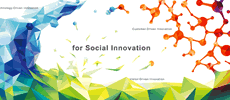Contribution[Part 2]New Ethics and a Return to the Roots of Ethical Capitalism (2 of 3)
Highlight
In the first article of Part 2, I observed that ethical capitalism represented a return to the roots of capitalism as originally proposed by Adam Smith. I asserted the need to move beyond “ethics and morals as they manifest in human societies as a whole” within the constraints of planetary boundaries, instead establishing “a new ethics and morality founded in the entirety of nature” that encompasses all of these societies. In other words, what is needed now is to explore ethics without losing sight of both this human path back to our roots and of the laws of the natural world for existing on this planet that set the bounds on this path. This, I believe, represents a more universal approach to ethics and morals.
Meanwhile, 2024 is the 150th anniversary of the birth of Hitachi’s founder, Namihei Odaira (1874-1951), someone who resolutely pursued the path of classical “ethical capitalism” as evident at Hitachi Mine. Accordingly, this article will focus on this man and consider how ethical capitalism is put into practice.
How Namihei Odaira Came to Specialize in Electrical Engineering
Odaira wrote “Konan Diary-Namihei Odaira's Posthumous Writings” in his younger days. Along with material held at Hiratsuka City Library, it tells of how the famous author and newspaper editor, Gensai Murai (1864-1927), who is known for the Meiji era best seller “Kuidoraku (The Gourmand),” spent time in Tochigi from 1886 to 1887, immediately after his return from a year-long visit to America. He stayed in the Odaira household for about six months and served as tutor to the two Odaira brothers, Gihei and Namihei [Murai’s father, Kiyoshi Murai, a scholar of the Chinese classics who also appears later in this article, was household tutor to Tokuji, Utako, and Kotoko Shibusawa, the children of Eiichi Shibusawa (1840-1931)]. These resources further inform us that Namihei Odaira came to respect Gensai Murai as a lifelong mentor and that, by virtue of having a tutor who had returned from time in America, he was able to study primary sources from overseas. We also see the process by which Odaira settled upon his decision to specialize in the field of electrical engineering, which would be crucial to the world’s future.
His diary entry for April 5, 1896, for example, tells us that Namihei Odaira visited Gensai Murai at his home in Azabu at the early hour of 8 AM. Murai proposed that they make an excursion to Tama River. They skirted the edges of the Yebisu Beer Brewery, passed by Meguro Fudoson, and proceeded to Futako Tamagawa. At Kameya (at that time an intellectual salon), they ate a meal of ayu (sweetfish) with a view of the clear waters of Tama River and then strolled along the river to Maruko Bridge. Odaira did not return to his dormitory until 11 PM that night, after lights out.
As it happens, I was born and raised in Komazawa in Setagaya and am familiar with the path they travelled, such that I can easily picture these sights in my mind, including Kameya. I can also readily imagine how they spent the entire day engrossed in conversation. It was thanks to his relationship with Gensai Murai that Namihei Odaira took research and development seriously from the very beginning. I can likewise surmise that Odaira was fascinated by the ideals of Fusanosuke Kuhara, the founder of Hitachi Mine. In 1912, Odaira invited Gensai to Hitachi Mine and its engineering facilities, repaying his past mentoring by spending three days telling him all about the site.
Column 1
Konan Diary, Namihei Odaira's Posthumous Writings
From his senior year in upper elementary school until his later life, it was Namihei Odaira’s custom to keep a diary, over 70 volumes in all. While some volumes were lost to fire in the war, about six and a half years of these diaries were published in 1954 under the title, “Konan Diary-Namihei Odaira's Posthumous Writings,” covering the period from January in his 20th year when he was enrolled at Dai-ichi Koto Gakko (First Higher School of Japan) to May of his 26th year when he was a student at the Electrical Engineering Department of the Imperial University College of Engineering (what is now the Faculty of Engineering at the University of Tokyo).
The young Namihei Odaira was more interested in art and sport than his studies and, being of a sensitive disposition, glimpses can be seen of how earnestly he struggled with the question of what he should do with his future. In this, I believe, we can see why he was so deeply devoted to Fusanosuke Kuhara (1869-1965), the founder of Hitachi Mine.
In the preface that opens “The History of Hitachi, Ltd.,” Odaira wrote that, “… something for which I cannot help but be grateful is the favor shown to me by Fusanosuke Kuhara and Yoshisuke Ayukawa. On a personal level also, I enjoyed the friendship of Kuhara from my time at Kosaka Mine onwards. It was through his strength that Hitachi got its start and so much of what it is today is due to the guidance and encouragement given me by these two men.”
In the end, Odaira was to pass away before Kuhara, the founder of Hitachi Mine. In “Memories of Odaira-san,” published by the Namihei Odaira Memorial Association in 1952, a year after Odaira’s death, he wrote the following, “… the friendship between Namihei and me goes back fifty years or so. After we first met at Kosaka, he came to work with me at Hitachi. While there were times when we would argue over things we were unhappy with, our friendship was never in jeopardy. While his wife may have understood it better than anyone else, it was the sort of friendship that I believe is a rare thing in this ever-changing world.”
I am conscious that something of what lay behind this relationship, the ideals that the two men shared, can also be found in the content of “Konan Diary-Namihei Odaira's Posthumous Writings.”
Column 2
“A Prophecy for the 20th Century” and Gensai Murai
Although Gensai Murai was born into the home of a (Confucian) scholar of the Chinese classics in the Yoshida Domain of Mikawa Province, his father, Kiyoshi Murai, provided him with a special education, wanting him to get an early start on the study of Western culture. At the age of 12, he was granted special admission to the Tokyo School of Foreign Languages (what is now the Tokyo University of Foreign Studies) when it opened in 1873. At the age of 20, he won an essay competition run by an English-language newspaper and as a result spent a year in America. This provided an opportunity to see American science and technology at first hand. After returning to Japan, he went on to became editor-in-chief in 1895 at the Yubin Hochi Shimbun Newspaper (the predecessor of Hochi Shimbun, one of Japan’s four major newspapers). In its January 2 and 3 editions in 1901, Hochi Shimbun ran a feature entitled, “A Prophecy for the 20th Century,” that presented predictions for science and technology, looking a century ahead to the world of 2001. There was a side of Gensai that we might now call a science fiction author and journalist, someone who dreamed of a utopia made possible by science and technology. Gensai had a deep personal relationship with Namihei Odaira (see Column 1) and the powerful influence he had on the youthful Odaira is also evident in “Konan Diary-Namihei Odaira's Posthumous Writings.”
Indications that “A Prophecy for the 20th Century” was written by Gensai Murai can be found in a number of sources, including at Hiratsuka City Library and Toyohashi City Library in his birth place. A 2005 White Paper on Science and Technology by the Ministry of Education, Culture, Sports, Science and Technology concluded that, in looking ahead 100 years, 12 of Murai’s 23 predictions for 2001 have come to pass, five have been partially realized, and six have failed to eventuate. On a close reading of these predictions however, you find that there are some more that may yet turn out to be correct. One that can generally be said to have clearly failed to occur is “ready speech between man and beast” (although this is a field of ongoing research using AI…). While the prediction for “Convenient ways of shopping” is judged to have been fulfilled in part, our present-day ability to make quick purchases on the internet is anything but a partial fulfillment. As such, “A Prophecy for the 20th Century” achieved a high level of prediction accuracy, a record that was rarely equaled even when looking overseas. Underpinning most of those predictions that did come true are the research and development of electricity and electronics.
As the above columns attest, this was a time when Namihei Odaira had a close association with Gensai Murai and engaged himself in a variety of exploits before starting work at Hitachi Mine in 1906. He would also have had access to the “A Prophecy for the 20th Century” articles published in 1901. That these predictions would prove to be highly accurate became clear 100 years later. It strikes me as a keen insight: that, out of those who dedicated themselves to the development of technology in its early days, the person who would turn out to be the founding president of Hitachi, Ltd. would be a leader who, in making his business decisions, had available to him a set of predictions for 100 years into the future. I believe this is something that warrants further exploration*.
- *
- In 1904, Gensai Murai relocated to Shonan Hiratsuka where he had acquired 16,400 tsubo (approximately 5.4 hectares) of land and devoted himself to his writing in earnest. With its vegetable garden and orchard, the Gensai home soon became a salon for food and culture, hosting Namihei Odaira, Shigenobu Ōkuma (a cousin of Gensai’s wife Takiko), Saburosuke Suzuki II, and Yanosuke Iwasaki (according to sources at Hiratsuka City Library). After the death of Gensai in 1932, Namihei Odaira took ownership of much of the large site at the request of Gensai’s widow, Takiko, with whom he was close. Along with his comrade, Naosaburo Takao (Vice President), they built second homes for themselves on the property while taking care to keep it in its original state. A monument still stands there with an inscription about how their conceptions of a great future for Hitachi were conceived and brought about at this place in Shonan. It was some 20 or so years after Hitachi was founded that it began exporting, a recognition of the quality of products it had developed itself.
Essentials for Ethical Capitalism
Moving further along, I would like to consider next what is needed to bring about ethical capitalism. If ethics and morals are to be put into practice, real-world capabilities are needed. High-minded pronouncements on their own are not enough to get things done.
I suspect that unethical actions frequently arise out of extremely self-centered thinking or from a weakness of mind. I redrew Maslow's hierarchy of needs from the perspective of the natural sciences (in Figure 3 in the third of the Part 1 articles), placing ethics at the apex of the pyramid and adding altruism.
While some exceptional people may live powerful lives no matter how poor they are, as in the notion of honest poverty, I expect the reality is that few people are able to acquire that sort of strength.
The same applies to companies. With strength and resolution, I believe it is possible to put ethical capitalism into practice. To achieve the strong finances needed to stay in business, a company needs a robust foundation, people, and education. In manufacturing in particular, forward-looking research and development are essential to building business strength.
Namihei Odaira first and foremost put a lot of effort into gaining an accurate understanding of production costs. Likewise with research and development, an analysis of research costs over the short, medium, and long terms is vital if this research and development is to remain beneficial long into the future. While this calls for a more holistic overview due to the need to look 10, 20, or 30 years ahead, my impression is that the research and development costing calculations used in investment analysis and elsewhere tend to diverge considerably from reality. Unlike with “A Prophecy for the 20th Century” above, things don’t always go how you expect. When the argument was put forward that there is no need for central laboratories in the generic sense, it was not very realistic, with most research and development being assessed on a timescale of about five years in some cases.
Column 3
At What Point Do AI and Other General-purpose Technologies Boost GDP?
On the 100th anniversary of the founding of the Royal Swedish Academy of Engineering Sciences (IVA) that I wrote about in the first article in Part 2, Erik Brynjolfsson, then a professor at MIT, gave an excellent presentation on innovation and the contribution of productivity to gross domestic product (GDP). He made the point that artificial intelligence (AI) and other general-purpose technologies (GPTs) (not to be confused with the other meaning of GPT) that have made a significant contribution to society do not deliver any economic benefits during their early research and development. Rather, it is only once an industry gets established that the importance of the technology is recognized by society.
The presentation included details of a future-looking cost analysis of AI research (up to 2018). As a proportion of GDP, the figure given for the entire AI industry was close to zero*.
- *
- Erik Brynjolfsson, “Artificial Intelligence and the Modern Productivity Paradox : A Clash of Expectations and Statistics, IVA 100th Anniversary (2019). (First reported in 2015).
This statement that AI made close to no contribution whatsoever to industry in GDP terms was made only four years prior to the explosive spread of ChatGPT and other generative AI technologies in 2023 (although the first paper was published some eight years earlier). While the world’s central laboratories and advanced research institutions drew criticism, there is much to reflect upon in the fact that the cost-benefit analyses conducted at the time only considered short-term outcomes, to the extent that they were effectively meaningless.
In fact, even now in 2024, there are already eye-catching examples of the commercial deployment of generative AI around the world. While very large investments are being made, moves are also underway to address ethics, including at the level of the European Commission, for example.
The key question I am addressing in this second article in Part 2 of this series is how the two kinds of capitalism can be connected, namely capitalism as an engine of innovation as envisaged by Joseph Alois Schumpeter (1883-1950) and the original form of ethical capitalism. The 150th anniversary of the birth of Namihei Odaira also serves as an occasion to consider this topic.
Germination of Research and Development in Early Years of Modern Industry
I will write about what happened in the early years of modern industry in an appendix. This year, 2024, marks the 150th anniversary of Namihei Odaira’s birthday. Odaira wrote about his own strengths and dreams in “Konan Diary-Namihei Odaira's Posthumous Writings,” saying, “My brain is that of a poet. The brain of a sentimental poet,” and “I crave to show my strength on the world’s stage.”
These self-observations by the young Namihei Odaira immediately bring to mind the physicist Pierre Curie (1859-1906), husband of Marie Curie (1867-1934), the famous discoverer of radium. Madame Curie described her husband as a poet physicist (in “Pierre Curie: With Autobiographical Notes by Marie Curie,” 1959).
It is a description that could be applied equally to Nikola Tesla, the inventor of the induction motor, who appears later in this article.
Column 4
Pierre Curie: A Scientist Recognized for his Poetic Character
In addition to his discovery of Curie’s principle (the law of preservation of symmetry), which has become a foundation of modern particle physics, Pierre Curie also bequeathed posterity with numerous practical inventions. He was a genius who left behind considerable creative accomplishments, including the discovery of the piezoelectric effect, the invention of the crystal oscillator and ultrasound machine, Curie’s law of magnetism and the Curie temperature, and the radiation treatment of tumors using the newly discovered radium. Some physicists also claim that he might have contributed to quantum theory and general relativity were it not for his premature death in an accident. While I will write more about him below, Nikola Tesla (1856–1943) was another genius blessed with the brain of a poet. It was Tesla who worked out the principles of the induction motor, the machine that would launch the Hitachi business. While inventors like Edison are also important, it is fascinating that so many of the inventions and discoveries that continue to hold their place into latter times are the work of scientists and engineers who think and feel like poets.
One can say that the chance encounter between Namihei Odaira and the like-minded Fusanosuke Kuhara was what secured the passage of Odaira’s dream into the real world. You can think of it as a genuine instance of the maxim “think globally, act locally,” whereby Odaira drew on his big ideas to establish a small “sogyo goya” (something like an entrepreneur’s garage) to which he then brought others in whom he saw future promise. In fact, another good example is how he strongly urged colleagues of his to come to the mine. These included his comrade Naosaburo Takao, the highly practical Kumeo Baba, and Daigoro Yasukawa. Daigoro started at the Imperial University College of Engineering after Odaira and came to the site for practical work over the summer vacation, where he was employed as an inspection manager from the very beginning (in 1912). Alternately, an impression of these strong-willed young men can also be gained by looking at their actions from the perspective of Daigoro Yasukawa. Sadly for Odaira, Yasukawa left Hitachi and traveled to the USA to learn more at the Westinghouse Electric and Manufacturing Company (what is now Westinghouse Electric Corporation), going on to establish Yaskawa Electric (what is now YASKAWA Electric Corporation).
As is widely known, Hitachi’s first steps were the manufacture of three five-horsepower induction motors into which Odaira and his colleagues poured considerable effort. When you look at the international situation at the time, their oft-mentioned achievement involving so much toil and struggle of creating a genuine made-in-Japan induction motor all on their own represented a first step toward their goal and can be thought of as the launch pad for their great dreams for the future. It is known that Odaira hated imitation. In other words, he valued a spirit of independence.
One type of household electrical appliance that uses an induction motor is an electric fan. While I will come back to it below, the extent of their skills was also to become known overseas when the export of fans to the USA commenced in 1926.
Genius of Nikola Tesla and Invention of Induction Motor
The induction motor was invented by Nikola Tesla, a genius from Croatia, an Eastern European nation on the shore of the Adriatic Sea. The idea for the motor first came to him in 1882 when he was 28 years old. Tesla became embroiled in a great controversy with Thomas Alva Edison (1847-1931) over whether power grids, including electricity transmission, should use alternating or direct current (AC or DC). More than just an inventor, Tesla was also a scientist and engineer in the mold of a visionary poet who throughout his life thought on a cosmic scale. While Edison persevered with DC, Tesla was in no doubt about the inherent advantages of AC. By utilizing the phenomenon of electromagnetic induction, he achieved a beautiful symmetry in which generators and electric motors are linked by the transmission of electricity via transformers. I can’t but feel that this way of thinking is similar to that of Pierre Curie, the man who developed the aforementioned Curie’s principle (the law of preservation of symmetry). In the end, AC was adopted for the Chicago World's Fair in 1893. This was because a distribution system that uses three-phase AC makes efficient use of each power line for the delivery of electric power. It also means generators and induction motors can take advantage of how electromagnetic induction operates across empty space to do away with the need for mechanical linkages in the form of commutators. Tesla considered oscillation and waves to be the essence of physical phenomena and that light was the origin of all things. He is believed to have had original insights into both quantum physics and general relativity.
Figure 1—Statue of Nikola Tesla in Zagreb, Croatia’s Capital, and Nikola Tesla Technical Museum Located near a Railway Station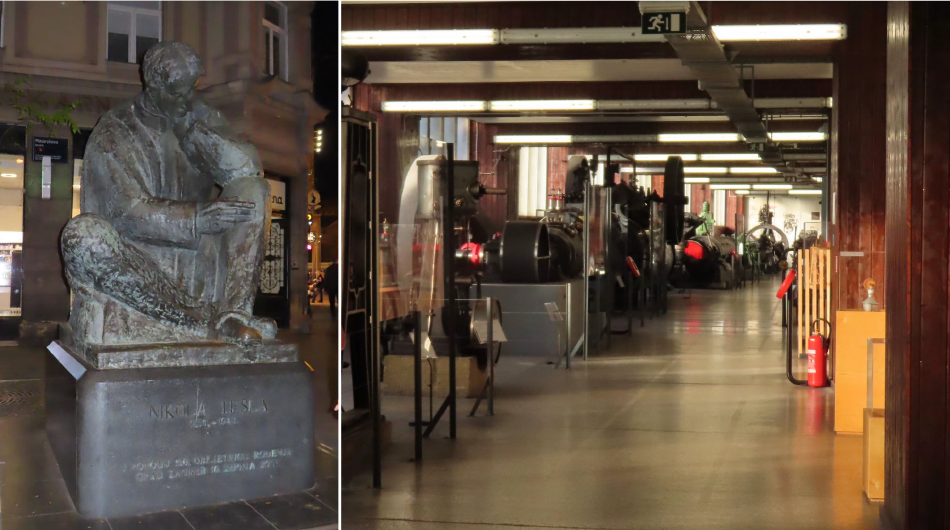 While Edison is widely known for his many inventions, it was by escaping the constraints imposed by his associated patents that led to the movie town of Hollywood in the American west and to the building of Tesla’s AC electricity generation and transmission systems. As an expression of their pride in Tesla, Croatia set up a memorial center to commemorate him and young Croatians have founded companies such as Rimac, which makes electric cars*. The photographs were taken by the author.
While Edison is widely known for his many inventions, it was by escaping the constraints imposed by his associated patents that led to the movie town of Hollywood in the American west and to the building of Tesla’s AC electricity generation and transmission systems. As an expression of their pride in Tesla, Croatia set up a memorial center to commemorate him and young Croatians have founded companies such as Rimac, which makes electric cars*. The photographs were taken by the author.
- *
- Rimac Automobile: A company that has grown rapidly since it was established about 10 years ago. It sells electric cars capable of maximum speeds above 420 kph and able to accelerate to 100 kph in 1.81 s.
Column 5
Invention of Induction Motor Inspired by Goethe Poem
Tesla recounted the following story in his book, “My Inventions.” It was from 1882 when he was in Budapest, Hungary. Taking an evening walk in a park, he was moved by the sight of a wonderful sunset to quote words from the Sunset Speech in Faust (said to be the most beautiful section in all of Goethe’s poetry). The following is an excerpt from the poem.
In the evening glow, we see
The houses gleaming, green-embowered.
Mild it retreats, the day that’s left,
It slips away to claim new being.
Ah, that no wing from earth can lift
Me, closer and closer to it, striving!
I’d see, in eternal evening’s light,
The silent Earth beneath my feet, forever,
The heights on fire, each valley quiet
While silver streams flow to a golden river.
(Translated by A. S. Kline)
Out of all the 12,110 lines of Faust, when I finally came upon these words, they left me with a visceral sense of how Tesla viewed the mundane world through a cosmic lens.
A golden sunset sets your heart beating, then comes a stillness. A stillness that is followed by the spread of a beautiful twilight. This is something I have seen in myself. Riding upon the turning Earth, eventually the rising sun becomes visible in the morning glow of the eastern sky (the author’s interpretation).
This hints at how the Earth is in fact the rotor of an induction motor. The Earth rotates as it floats in space. Inside the rotating magnetic field generated by the stator, the rotor is able to float, just like the Earth, with no electrical contact. The oscillating magnetic field induces an electric current in the rotor that in turn drives its rotation. It is a truly beautiful system.
Tesla recounts how, while reciting these lines of poetry, he used the branch from a tree to draw a diagram of an induction motor on the ground at the park. This happened in 1882. In the following year of 1883, Tesla built a prototype of the motor at a workshop in Strasbourg and confirmed that it did in fact rotate. He also wrote that the drawing he used when subsequently making a formal announcement of his invention (in 1888) was exactly the same as the one he drew on the ground [Nikola Tesla, “My Inventions,” Electrical Experimenter magazine (1919)].
Beginnings of Hitachi, Ltd.
As I wrote in the column, whereas the key idea behind Tesla’s invention of the induction motor came in 1882, the subsequent experimental testing and improvement and the acquisition of a patent did not happen until 1888. Likewise, the successful manufacture by Namihei Odaira of a genuine made-in-Japan five-horsepower induction motor came in 1910, 28 years after Tesla’s original idea.
Odaira got a job at the Tokyo Electric Light Company (what is now Tokyo Electric Power Co., Ltd.) in anticipation of the role that electricity would play in future society, and this gave him insight into the reality of Japan at that time. The most advanced work being done back then involved the use of imported turbines and generators from foreign companies such as GE (USA), Westinghouse (USA), Siemens (Germany), and Escher Wyss (Switzerland), the installation of which was overseen by engineers who had come to Japan from overseas.
“Konan Diary-Namihei Odaira's Posthumous Writings” records Odaira writing about his astonishment at the primitive state of Japanese factories during his time in the Electrical Engineering Department at the Imperial University College of Engineering. Rather than seeing its superficial splendor, I believe that it was because Odaira was clear-eyed in his assessment of the state of Japan that he chose to go to Kuhara’s Hitachi Mine and set about working on his plans.
Figure 2—Principle of Induction Motor Superimposed on Hitachi Mark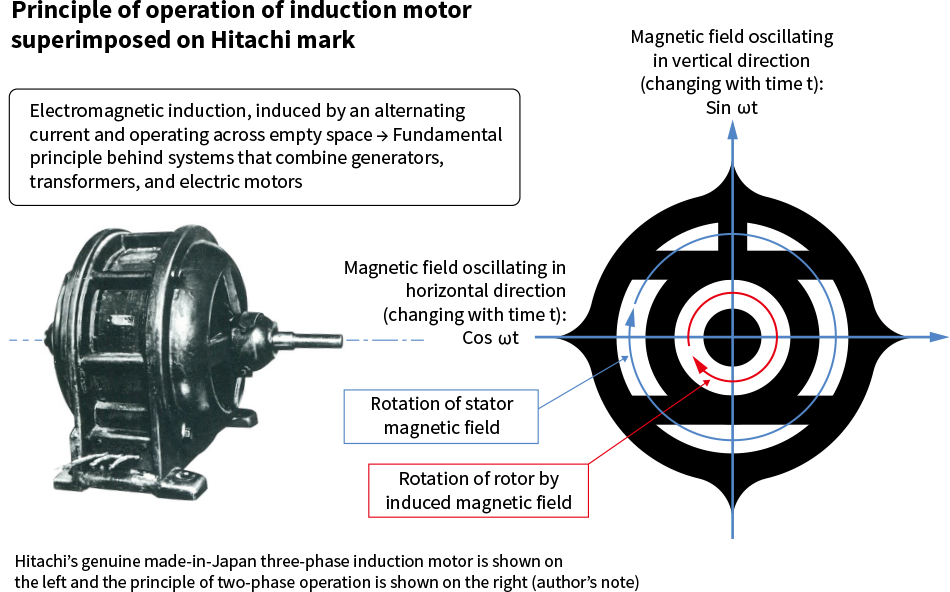 The Hitachi mark was designed by company founder Namihei Odaira himself and was something he thought about before Hitachi, Ltd. was established. It combines “◉,” a version of the kanji character “日” (“hi,” meaning sun) used in classical literature and “立” (“tachi,” which represents a person with arms and legs extended viewed from the front). While it is often held to express Hitachi’s presence as a sun with its rays in the background, my own thought is that it also encapsulates the principle of operation of an induction motor and generator.
The Hitachi mark was designed by company founder Namihei Odaira himself and was something he thought about before Hitachi, Ltd. was established. It combines “◉,” a version of the kanji character “日” (“hi,” meaning sun) used in classical literature and “立” (“tachi,” which represents a person with arms and legs extended viewed from the front). While it is often held to express Hitachi’s presence as a sun with its rays in the background, my own thought is that it also encapsulates the principle of operation of an induction motor and generator.
It is said that induction motors currently account for 40 to 50% of global electricity consumption. In Japan, the figure has been estimated to be about 55%, representing about 75% of all industrial energy use*.
- *
- https://www.jema-net.or.jp/jema/data/S5238(20211220).pdf (in Japanese)(PDF Format, 10.6MB)
When broken down by usage, 57.3% of the 999.6 TWh of electric power consumed in Japan in 2005 was used by motors (32.9% for motive power, 24.4% for air conditioning and cooling), 13.6% by lighting, 9.5% by electrical heating, 4.7% by IT equipment, and 14.7% by other loads*. - *
- https://www.sicalliance.jp/data/doc/1504061424_doc_5_1.pdf (in Japanese)(PDF Format, 1,075KB)
As these figures show, it is no exaggeration to claim that the world runs on AC systems. Even most of the electric motors used in battery electric vehicles are AC and I hope this serves as a reminder of how, being an emblem of the entire electricity industry, the Hitachi mark carries a deep significance.
World-leading Initiative Happening in Parallel
Meanwhile, a chimney completed under the direction of Fusanosuke Kuhara was to become a model for future environmental measures. At more than 150 m in height, it was the tallest chimney in the world at the time of its construction. In a feat of great ingenuity, it was also the first to be built using reinforced concrete. It was an astonishing accomplishment, being entirely Japanese made and erected very quickly, with the work starting in 1914 and completing just a year later, proof that determination, ingenuity, and world-leading technology existed on Japanese soil. Moreover, the driving force behind the project was ethics.
Figure 3—Remains of Development Chimneys and Great Chimney at Hitachi Mine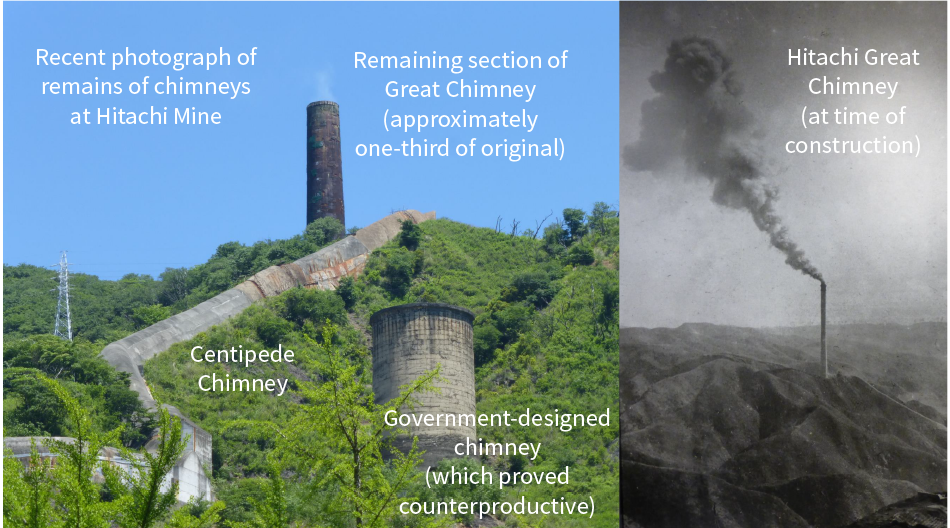 As shown in the photograph on the right, the 155.7-m Great Chimney was constructed on a ridgeline in defiance of accepted wisdom at the time. The elevation at the top of the chimney is close to 500 m. As a result, the heavy sulfurous gases are caught by high-level updrafts and dispersed into the upper atmosphere.
As shown in the photograph on the right, the 155.7-m Great Chimney was constructed on a ridgeline in defiance of accepted wisdom at the time. The elevation at the top of the chimney is close to 500 m. As a result, the heavy sulfurous gases are caught by high-level updrafts and dispersed into the upper atmosphere.
Although efforts to capture the gas as sulfuric acid date back to the time of the Great Chimney’s construction, this was not successfully accomplished until much later. The marvel that was the chimney stood for approximately 80 years until 1993, withstanding both typhoons and earthquakes and fulfilling its vital purpose. Although now only one-third of its original height, it still remains in use emitting a thin wisp of white smoke.
This was a time when the practice of welding steel did not yet exit. For example, the unexpected sinking of the Titanic after it ran into an iceberg happened in 1912, shortly before construction work began on Hitachi’s Great Chimney. Lacking any ability to weld steel plates, the plates that made up the hull of the Titanic were instead held together by wrought-iron rivets. These rivets popped on contact with the iceberg, opening a large gap as the steel plates peeled loose. It was this that caused the sinking (as was discovered by a survey of the sunken wreck). Figure 4 shows a photograph of riveted steel plates on the Titanic.
Figure 4—Stern Section of Titanic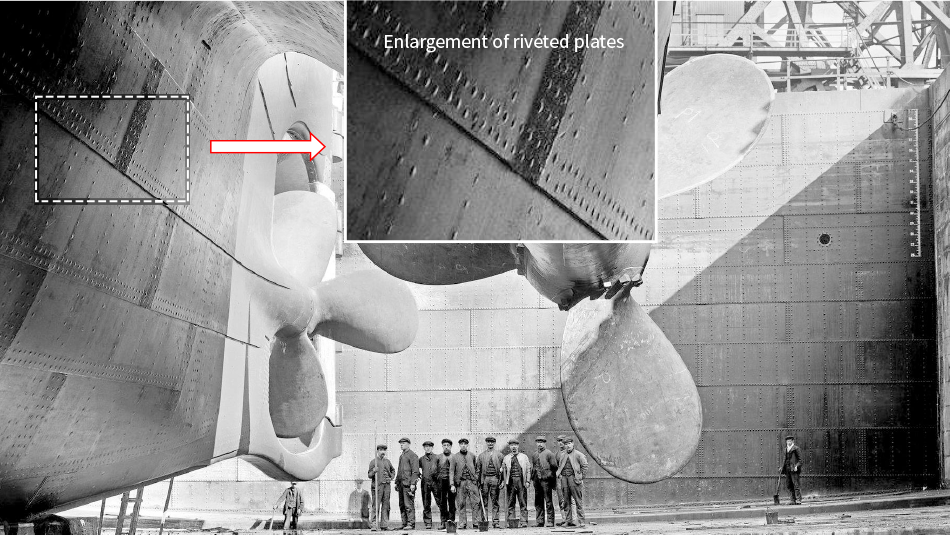 The steel plates that lined the ship’s hull were held together by rivets. The ability to weld steel plates did not exist at the time of construction in 1912. The riveted plates came away on contact with the iceberg, letting in large amounts of water. The photographs show double rows of riveting in the ship’s stern that, like its bow, was reinforced.
The steel plates that lined the ship’s hull were held together by rivets. The ability to weld steel plates did not exist at the time of construction in 1912. The riveted plates came away on contact with the iceberg, letting in large amounts of water. The photographs show double rows of riveting in the ship’s stern that, like its bow, was reinforced.
When you research the four large copper mines in Japan at that time, you find that the ways they dealt with pollution were completely different. Conscious of ethics, Besshi Copper Mine put a lot of effort into this work. In one instance from 1936, where even relocating the smelter showed no prospect of improvement, they tried to improve pollution by the direct approach of capturing the sulfur dioxide gas as sulfuric acid. As it turned out, only Hitachi Mine was able to successfully address the issue. Nor were the problems limited only to mines, with industrial companies elsewhere being responsible for two different outbreaks of Minamata Disease. Viewed through the lens of modern ethics, many would say that the companies concerned should never have put in the plants in the first place.
Research and Development with Ethics at its Foundations
―Goal Shifts from Domestic Production to Exporting―
The Great Kanto Earthquake struck in 1923. While Kameido Works was partially destroyed, there was no damage in Northern Ibaraki. With orders flowing to Hitachi Works under favorable conditions, Odaira gathered his sales staff and announced the following strategy: “This great disaster has devastated the Keihin region, the nerve center of our country. Right now, we need to make this region’s recovery our top priority. We must not act irresponsibly by overloading our factories with orders from other regions. We need to mobilize the full capabilities of all our plants to accomplish the recovery as quickly as we possibly can.” The delivery of a prototype rotary converter that was under construction for the Kanda Substation of the Ministry of Railways (in the disaster-affected area of Tokyo) was expedited, enabling the restoration of power between Tokyo and Ochanomizu Station. Hitachi also played its part in getting the city’s electrical infrastructure back up and running, supplying and repairing rotary converters and electric motors for Tokyo Shiden (Tokyo’s tram network). The focus was on work that facilitated the recovery, including doing everything possible to ramp up production of transformers and other electrical distribution equipment and expediting their delivery to the Keihin region. While this was a practical demonstration of the spirit of ethical capitalism, putting the public good ahead of profits, it ultimately resulted in an expansion of Hitachi’s business.
In 1926, 30 fans were dispatched to the USA in what was Hitachi’s first ever export consignment, making it a pioneer in the globalization of Japanese industry.
It can be assumed that Odaira thought of companies as public institutions (existing for the good of society) and that he faithfully adopted Kuhara’s ideas of ethical capitalism. If a company is to contribute to society, it needs a sound financial foundation to survive. We can see from ledgers preserved at the Nippon Mining Museum that he redoubled his efforts to put cost accounting practices in place from an early stage, following the principle that “costing is at the core of business.” Even if what you do is helpful for society, those efforts are meaningless if they cannot be sustained. It goes without saying that this point matters more than any other for a business. I also believe that Odaira’s establishment of a research team in 1918 was founded on his belief in working for today while also engaging in research with goals that stretch 10 or 20 years into the future.
The 1901 articles entitled “A Prophecy for the 20th Century” that I wrote about earlier feature much that, 100 years later, would be the fruit of research work undertaken by Hitachi. Even now in 2024, they still exert a large influence in science and technology policy.
One can also conclude that a fusion of science and the humanities began early in Namihei Odaira’ s thinking.
“The independent spirit possessed by Hitachi manifested also in technology. Whereas other Japanese companies engaged in technical partnerships and accepted investment from foreign partners, Tokyo Shibaura Electric Co., Ltd. with General Electric (GE), Mitsubishi Electric Corporation with Westinghouse, and Fuji Electric Co., Ltd. with Siemens, Hitachi from the very beginning championed the domestic production of electrical equipment using its own technology. When Odaira proposed to Kuhara in September 1919 that Hitachi be spun off from Kuhara’s mining business, the latter suggested that its establishment as a separate entity could be expedited by a partnership with an overseas electrical manufacturer (suggesting that Siemens fill this role). Similarly, his friend Motoji Shibusawa (the founding president of Nagoya Imperial University) described Odaira’s plans as reckless. Rather than responding to this advice, Odaira persevered with the development of Hitachi’s own technologies.”*
“Based on this business strategy, the Hitachi workshops established an equipment-testing section in 1914, three years after becoming an independent operation. This was done to strengthen the links between design and production activities as well as to work on developing its own technologies and on making progressive improvements to its products.”
- *
- Susumu Ishii, “The History of the Development of Electronics Industries in Japan (2): Formation of a Research & Development System and Impact of Foreign Technology Introduction,” Gakushuin Economic Papers, vol. 57 (4), pp. 183–230 (2021)
While Kuhara’s advice was given from an international perspective, it may be that Odaira’s successful perseverance with his strategy of developing original technology represents an instance of the pupil surpassing his master. In this, it seems no exaggeration to say that Hitachi rested on the shoulders of its founding president, Odaira. In my own humble interpretation, what seems exceptional to me is the thinking of Kuhara, someone who persevered with the concept of ethical capitalism to build a chimney unlike any before it near the top of a hill, one that was also the world’s tallest.
With Namihei Odaira being as sincere and big-hearted as he was, the people around him must have found it a struggle to keep up.
Eschewing the party line, the following account took an objective look at the state of Japan’s electrical equipment industry. Once again, I am quoting from the writing of Susumu Ishii.
“In Hitachi’s case, there was a stronger will to focus on the development of its own technology rather than bringing it in from outside and it is notable that the independence of the research division was given a high priority from very early on. One initiative that followed from this sense of purpose was the establishment of a central laboratory, something that set Hitachi apart from the other two companies [Toshiba Corporation and Mitsubishi Electric Corporation]. Hitachi’s Central Research Laboratory was established in April 1942. While this was in the middle of the Second World War, planning for the laboratory commenced in earnest in July 1939. This happened in large part through the initiative of Namihei Odaira and the emphasis was on progressing fundamental research based on the goal of working for today while also engaging in research with goals that stretch 10 or 20 years into the future.” The goal that Odaira had in mind for his central laboratory was fundamental research.
Figure 5—From Hitachi Hyoron’s First Issue (Published 1918) to its 1,000th (Published 2005)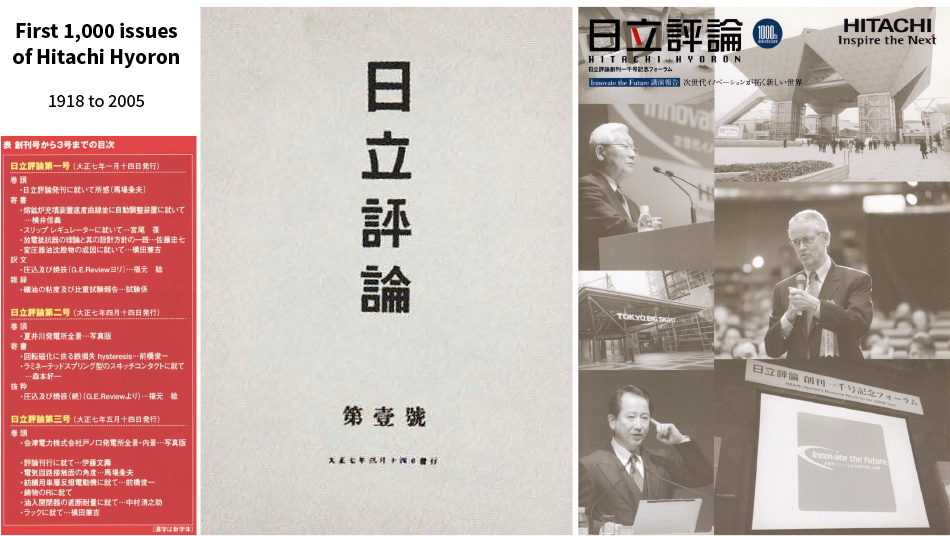 The year 1918, when the technical journal Hitachi Hyoron was first published, was also the year in which the equipment-testing section at the Kuhara Mining Company’s Hitachi workshops was upgraded to a department and a new research team was established. A commemorative edition marking the 1,000th issue of the journal was published in 2005 and a symposium to mark the occasion was held at Tokyo Big Sight. [From the top, the photographs on the right show Etsuhiko Shoyama (1936-2020), the seventh president of Hitachi, Ltd.; Charles “Chuck” M. Vest (1941-2013), a former president of MIT; and the author.]
The year 1918, when the technical journal Hitachi Hyoron was first published, was also the year in which the equipment-testing section at the Kuhara Mining Company’s Hitachi workshops was upgraded to a department and a new research team was established. A commemorative edition marking the 1,000th issue of the journal was published in 2005 and a symposium to mark the occasion was held at Tokyo Big Sight. [From the top, the photographs on the right show Etsuhiko Shoyama (1936-2020), the seventh president of Hitachi, Ltd.; Charles “Chuck” M. Vest (1941-2013), a former president of MIT; and the author.]
Hitachi Group’s Research Laboratories
“In 1918, the equipment-testing section was upgraded to a department and split into an equipment-testing section and research team. This research team was the forerunner of the Hitachi Research Laboratory of Hitachi, Ltd. From its establishment, the equipment-testing department was independent of the factory, focusing on investigating issues from a fair and neutral standpoint. In this research team, the mantra of original technology development was continually emphasized. The research team was in turn upgraded to laboratory designation in 1934 and the research function considerably expanded. Another organizational change came in 1939 when the laboratory was split off from Hitachi Works and placed directly under head office management to serve as an independent research facility for the three plants at Hitachi, Taga, and Mito. The focus of the early research team and laboratory was on new product development, especially in the field of electrical materials, with work on improving insulators and producing them domestically. By around 1932 and 1933, the emphasis had shifted to fundamental research and the elucidation of the theory behind electrical phenomena, with the hiring of graduates from physics faculties.”*
“Because of this focus on fundamental research, management of the laboratory adopted the following practices for funding the laboratory’s costs. Rather than using a system in which each research project was billed to the relevant plant, the work was bulk-funded from the head office budget based on standard cost allocation rates. As Kumeo Baba, the first head of the laboratory, placed a particular emphasis on maintaining close links to the plants, it seems that getting the relationship between the Central Research Laboratory and operational divisions right involved an extended period of trial and error.”
Given that this research paper includes details of company history, I expect that the checking of primary sources was essential to its compilation.
- *
- Susumu Ishii, “The History of the Development of Electronics Industries in Japan (2): Formation of a Research & Development System and Impact of Foreign Technology Introduction,” Gakushuin Economic Papers, vol. 57 (4), pp. 183-230 (2021)
Figure 6—Central Research Laboratory of Hitachi, Ltd. (circa 2000)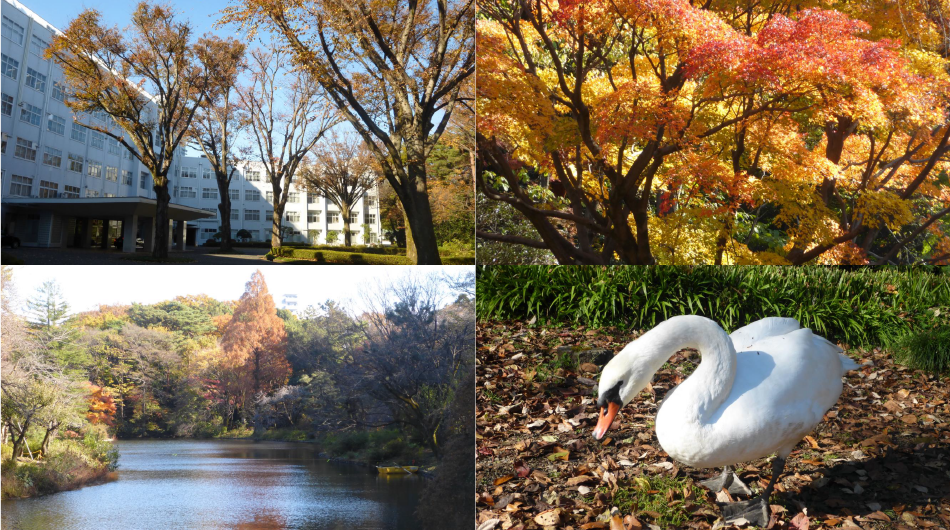 The Central Research Laboratory is located on the Kokubunji Cliff Line and its site includes a number of springs that feed the Nogawa River, ultimately flowing into the Tama River. Remnants of the original Musashino forest still remain and there was wasabi growing wild in the springs when I took these photographs.
The Central Research Laboratory is located on the Kokubunji Cliff Line and its site includes a number of springs that feed the Nogawa River, ultimately flowing into the Tama River. Remnants of the original Musashino forest still remain and there was wasabi growing wild in the springs when I took these photographs.
The Central Research Laboratory has worked primarily on electronics and optics. The laboratory has produced devices such as transistors, computers, lasers, and measurement instruments. As considerable documentary material has already been published on the Hitachi Central Research Laboratory, I will refrain from going into more detail here.
Taking Hitachi Advanced Research Laboratory into 21st Century
Figure 7—Hitachi Advanced Research Laboratory (HARL) (circa 2010)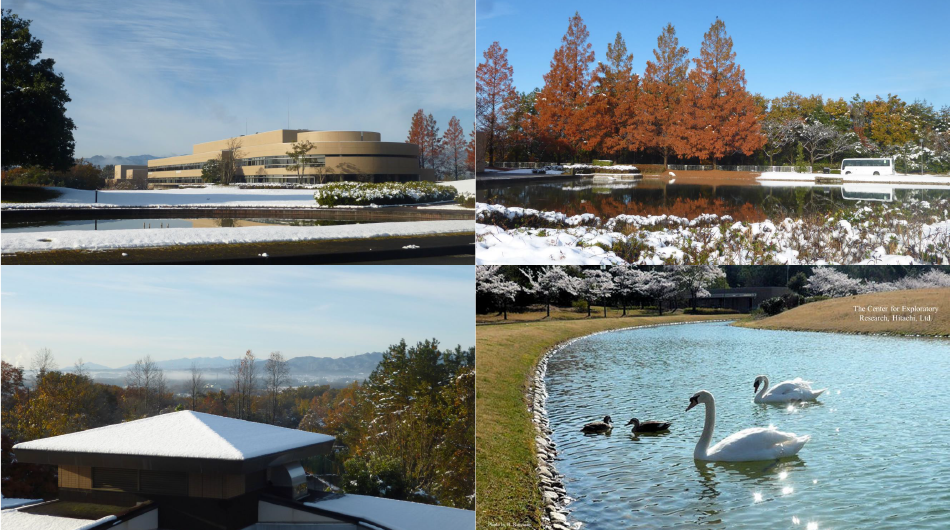 The Advanced Research Laboratory stands atop Hiki Hill on an expansive 40-hectare site. It is a modern laboratory, established in 1990. (Initially established in 1985 at Kokubunji, it subsequently relocated to Hatoyama where it commenced work in earnest.) On the occasion of a visit by the Emperor when he was still Crown Prince, he felt that the pond was in need of swans and so donated two pairs (photographs by author).
The Advanced Research Laboratory stands atop Hiki Hill on an expansive 40-hectare site. It is a modern laboratory, established in 1990. (Initially established in 1985 at Kokubunji, it subsequently relocated to Hatoyama where it commenced work in earnest.) On the occasion of a visit by the Emperor when he was still Crown Prince, he felt that the pond was in need of swans and so donated two pairs (photographs by author).
While designated the Advanced Research Laboratory, the distinction between foundational and applied research depends on the length of time from initial studies to the delivery of results.
Figure 8—Basic Strategy for Taking Hitachi Advanced Research Laboratory into the 21st Century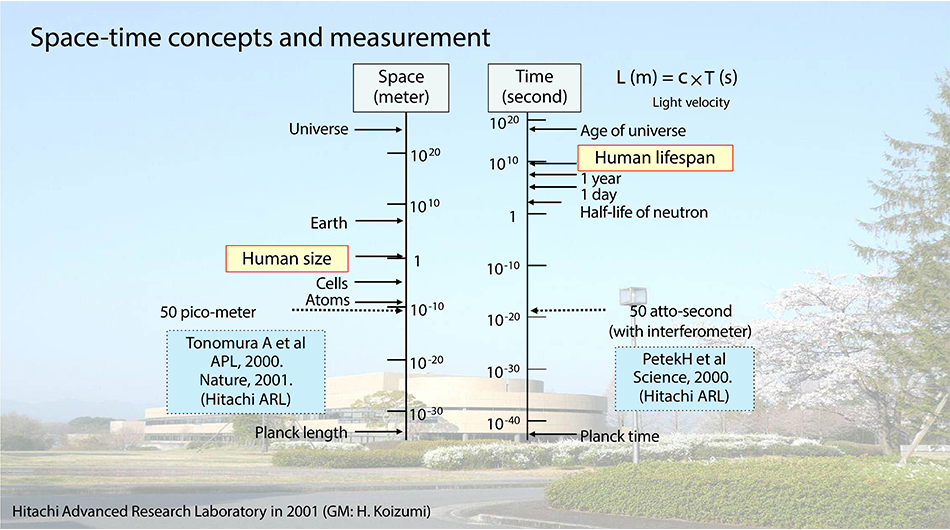 A diagram by the author placing the Hitachi Advanced Research Laboratory in the wider scheme of things, created back in 2000 and looking ahead to the 21st Century. It considers time and space on a scale that spans from the universe down to the Planck length and Planck time. This was at a time when Hitachi Advanced Research Laboratory possessed world-leading measurement technologies, achieving spatial resolution of 50 pico-meters (10−12 m) using an ultra-high-voltage (1,000,000 V) electron microscope and time resolution of 50 atto-seconds (10−18 s) using a laser interferometer with ultra-short pulses. It was also at around this time that a number of world-leading technologies for the physical measurement of human thought processes were transferred from Hitachi Central Research Laboratory.
A diagram by the author placing the Hitachi Advanced Research Laboratory in the wider scheme of things, created back in 2000 and looking ahead to the 21st Century. It considers time and space on a scale that spans from the universe down to the Planck length and Planck time. This was at a time when Hitachi Advanced Research Laboratory possessed world-leading measurement technologies, achieving spatial resolution of 50 pico-meters (10−12 m) using an ultra-high-voltage (1,000,000 V) electron microscope and time resolution of 50 atto-seconds (10−18 s) using a laser interferometer with ultra-short pulses. It was also at around this time that a number of world-leading technologies for the physical measurement of human thought processes were transferred from Hitachi Central Research Laboratory.
Back in 2000, I was responsible for a wide range of fundamental scientific fields in my role as the fourth person to lead Hitachi’s Advanced Research Laboratory (as General Manager). I also had a “player-manager” role, participating as part of a research group that worked primarily on neuroscience and its applications. The group I managed directly had since 1982 been working on functional measurement techniques based on the principle of magnetic resonance imaging (MRI) as well as on functional magnetic resonance imaging (fMRI) and the rendering of magnetic resonance angiography (MRA). This served as the foundation on which subsequent work was undertaken at the Advanced Research Laboratory from around 2000 onward.
This work on measurement that extends from physical properties to the functioning of the human mind is a task that brings the natural sciences into contact with the humanities and social sciences. This is not to say that our arguments took us into territory that transcended the boundaries of these respective fields. Rather, it was a quest, unprecedented in history, to bring the natural sciences and the humanities and social sciences together, performing physical measurements on the functioning of a thinking modern human brain and thereby capturing the operation of this organ capable of conjuring up philosophies and ideas. Another way of putting it is that it represents a way of making objective what has previously been treated as subjective, opening it up to logical argument. It also has many potential applications such as scientific approaches to learning and education.
The work was highly regarded internationally, including being named by the MIT Technology Review magazine as one of the four great breakthroughs for FY2001*.
- *
- “ Hitachi Advanced Research Labs’ brain science applications program breaks the mold with research to improve education through brain imaging,” (MIT Technology Review,R&D 2002: Advanced Brain Imaging).
When it comes to obtaining crucial primary sources, rather than “give and take,” it is “give, then take” that is needed. While basic property rights first need to be acquired, after that, what I feel is important is to make the information public and to share it with many others. It is only when a new idea is expressed that valuable primary-source information can be gathered, including from overseas. Likewise, to obtain valuable feedback, consulting directly with the people at the forefront of the field concerned is essential. Often, a simple word is all it takes. It was thanks to this work gaining widespread coverage in the MIT Technology Review that we were able to get help from numerous important researchers. By doing so, prediction accuracy was further improved.
Moreover, the successful realization of a means of observing the functioning of a living brain represents a provocative development in the field of academia. This is because “thought” lies at the core of the natural sciences, the humanities and social sciences, and even everyday society. It is our brains that prompt our actions and everything else we do. It is also because providing clarity about how the brain works will bring change at every level to all areas of human activity.
Symposiums Hosted Jointly by Hitachi Central Research Laboratory and Hitachi Advanced Research Laboratory and Open to Other Companies
As neuroscience and its applications are a classic example of an interdisciplinary field of study, it is not possible for individual companies or universities to do worthwhile work in isolation. It was only natural, then, that it became an area of open innovation in the early 1990s. I facilitated a session on brain function measurement at the Probing into the Brain forum [hosted by the Research Development Corporation of Japan (JRDC)] that took place after a Science and Technology Agency forum in 1994. Not long after, the third Hitachi Central Research Laboratory symposium entitled “The Frontiers of Mind-Brain Science and its Practical Applications” was held at the Hitachi Central Research Laboratory hall on January 25, 1995. The stated purpose of the symposium was, “To obtain an overview and understanding, at each level in the hierarchical structure of the brain, of the latest developments in the mind-brain science that is recognized as lying at the foundations of 21st-Century science and technology. Based on this fundamental understanding of brains and neuroscience, to look ahead at the wide-ranging applications for neuroscience and to facilitate more in-depth and targeted debate on the emergence of this field. Also, given the importance of collaborative arrangements for research in academia, to serve as a forum for enhancing exchanges between researchers from different disciplines.” The symposium was also an attempt to capture a panoramic view of the future, leaving nothing out, with Hitachi’s corporate competitors also being invited to attend along with researchers from Japan’s public and private universities and research institutions who are recognized, both here and overseas, as playing a prominent role in their fields. A total of 18 companies gathered in the Hitachi Central Research Laboratory hall.
In response to interest expressed by the academic community in particular, a second symposium was held some five years later in 2000, this time being co-hosted with the Hitachi Advanced Research Laboratory. Coming at the beginning of the 21st Century, it provided an opportunity to explore the future of brain- and neuro-science in terms of both its foundations and its applications.
Figure 9—Hitachi Central Research Laboratory Symposiums Involving Collaboration between Industry, Government, and Academia (the 2000 Symposium was jointly hosted by the Central Research Laboratory and Advanced Research Laboratory)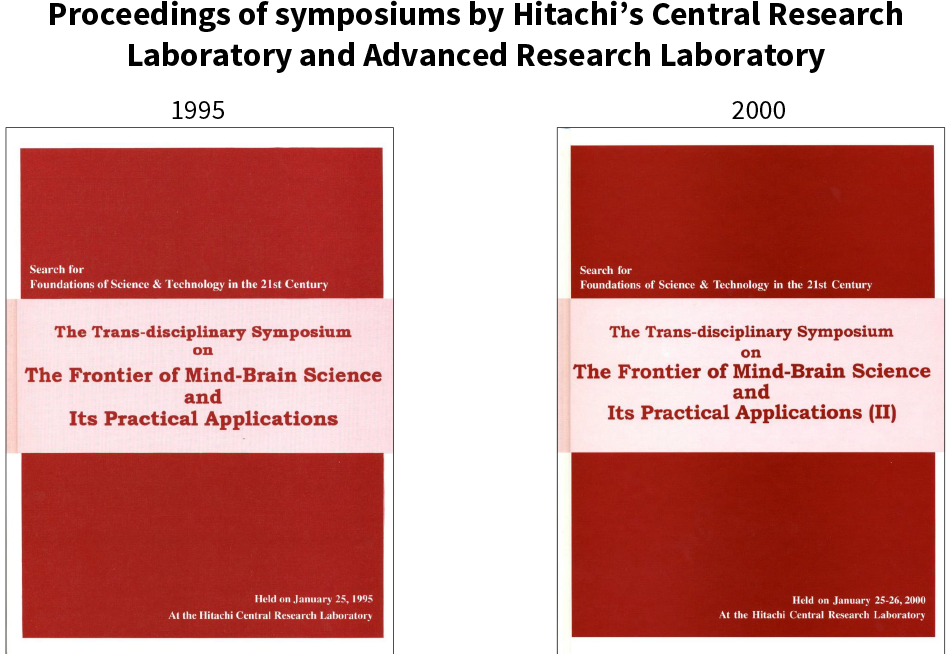
Corporate Collaboration on Fundamental Research at Pre-competitive Stage
As competition between private-sector companies is intense, it is generally assumed that these companies routinely keep their research and development behind closed doors. At the pre-competitive stage, however, working together is an accepted practice, internationally as well as in Japan. To understand why, consider patents as an example. These have been called “thousand-to-three longshots” in the sense that, out of a thousand patent fillings, perhaps only three will prove to be genuinely useful. Research and development goes on day and night at all sorts of different companies, from large corporations to small and medium-sized enterprises (SMEs), spin-offs, spin-outs, and start-ups. While a new paper can be published and catch people’s attention whenever something new is discovered, it does not work this way for products. Even if a product combines several attractive ideas, it only takes one unresolved problem for it to fail in the marketplace. This makes it inefficient for lots of companies to compete with one another in the early stages of research and development. It is vital, rather, that they collaborate before entering into market competition to determine whether what they are working on has a viable future.
To enable the sharing of “primary-source information” in the early years of a new field, it is a common practice for large corporations to enter into formal contracts with one another to engage in fundamental research. At my own laboratory that works on Hitachi medical equipment, for example, we invited talented young researchers from Siemens to work with us for periods of one or two years. We have also visited the corporate research centers of companies like GE in the USA and Philips in the Netherlands to learn from them and spend time in their many laboratories. I see this as a basis for ethics that is different from compliance. Even after having cooperated on fundamental research, companies continue to compete with one another after entering the market competition phase by striving to come up with further new ideas and protecting them with patents. This has proved very useful when launching something new onto the world.
Corporate research centers like Bell Labs or IBM Research that produced numerous Nobel Prize winners had their heyday some time ago. Back then, there was also a time when the heads from almost all of the advanced research laboratories would gather for a round-table conference every few months where they would hold serious discussions about the foundations of research and development (see column 6).
Figure 10—Presentation by Author on Predicted Future Developments in Higher-order Brain Function Measurement Given at the Hitachi Central Research Laboratory Symposium (and Published Simultaneously) and Predicted Emergence of New Fields Using these Techniques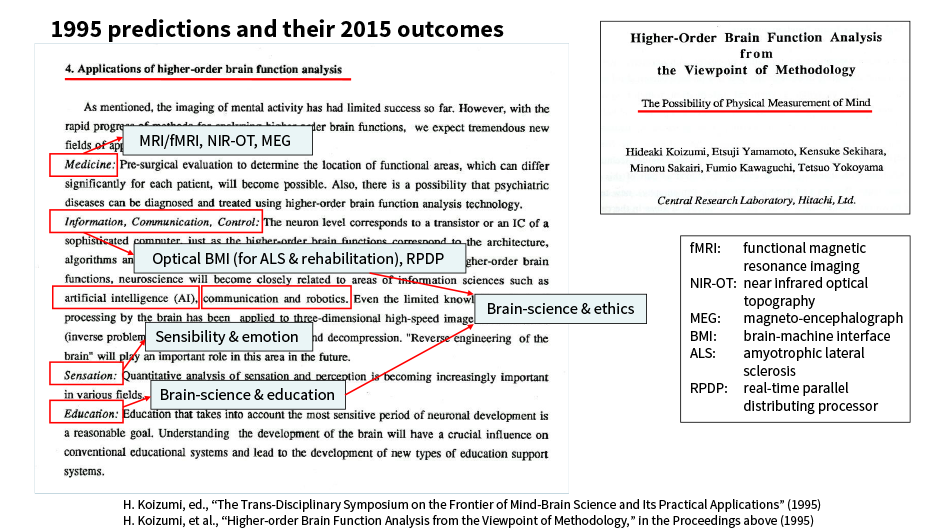 Entitled, “Higher-order Brain Function Analysis from the Viewpoint of Methodology,” the presentation predicted advances in higher-order brain function measurement and the emergence of new fields based on these techniques. In the figure above, I have overlaid the different forms in which these techniques have been implemented, as of 2015 (20 years later)
Entitled, “Higher-order Brain Function Analysis from the Viewpoint of Methodology,” the presentation predicted advances in higher-order brain function measurement and the emergence of new fields based on these techniques. In the figure above, I have overlaid the different forms in which these techniques have been implemented, as of 2015 (20 years later)
As can be seen in Figure 10, almost all of the predictions for the future of brain- and neuro-science made in 1995 had remarkable results to show for themselves by 2015, 20 years later, with research and development underway in each case, both in Japan and overseas.
The following is a summary of the specific predictions given in Figure 10.
- MRI: The application of MRI (including fMRI) to measurement, the use of new near-infra-red optical topography (NIR-OT) to perform measurements on the mind under natural conditions, and the availability of magnetoencephalogram (MEG) machines. Also, these technologies will find practical applications, starting with use in medicine and including mental health.
- New information, communication, and control technologies: Applications in a range of fields
- Contribution to new developments in the emerging fields of artificial intelligence (AI) and robotics
- The ability to acquire quantitative measurements of sensation, with applications to emotion and reasoning
- Education: Enabling the emergence of education as a science
- An emphasis on measuring brain function (especially higher-order brain function) in live human subjects that will facilitate a fusion of the natural sciences with the humanities and social sciences
Figure 10 also shows whether or not each of these predictions had come true 20 years later, in 2015. The results for the six predictions listed above are as follows.
- For the first time ever, psychiatry, a field that had previously lacked measurement instruments and relied primarily on patient consultations and history taking, now has access to devices able to distinguish between different mood disorders (depression, bipolar disorder, and schizophrenia). In the case of epilepsy, non-invasive measurement is now available for locating the portion of the brain where seizures originate, enabling surgical removal. Accordingly, this is now covered by insurance in Japan. Having gained approval under Japan’s Pharmaceutical Affairs Act, this technique has been listed for health insurance coverage and come to be used in routine clinical practice.
- It is now possible to communicate with patients who have amyotrophic lateral sclerosis (ALS) and are in a “locked-in state” (a vegetative state in which they remain conscious but are unable to move their body). This has also opened up a new field of rehabilitation.
- Fabrication of the world’s fastest neuromorphic semiconductor chip that works on the principle of real-time parallel distributing processing (RPDP), which is the fundamental architecture of the brain. (One of the goals of this technology is use in robotics where there is a requirement for near-real-time execution of deep learning AI.)
- A research and development project for achieving targeted and quantitative measurement of emotion and for putting this into use was undertaken as part of a major national project.
- Studies are now underway in the new field of learning and education informed by neuroscience. An OECD global project (Learning Sciences and Brain Research) ran for approximately 10 years from 2000. An academic journal entitled “Mind, Brain and Education” was also launched by Blackwell (now Springer) in 2005 [and was named the Best Journal of the Year by the Association of American Publishers (AAP)].
- Considerable work is being undertaken that uses neuroscience to underpin a merging of the natural sciences with the humanities and social sciences under designations such as “bridging and fusion of different fields,” “cross-disciplinary studies,” “ultra-interdisciplinary studies,” and “trans-disciplinarity.”
How is it that almost all of the predictions came to pass?
The primary reason, as I have asserted from the beginning of this article, was the considerable input we received from leaders in the field from overseas. What sort of people are they who are truly at the forefront of their field? They are people who accurately recognize the reasons or basis for why they do not yet understand something. This is a conclusion I came to truly appreciate from ongoing deeply insightful discussions at numerous international conferences. You find such people gathering unexpectedly at the most unlikely occasions, sharing new ideas with one another.
Two Fields that Hitachi Advanced Research Laboratory was not Inclined to Pursue in 2000: High-temperature Superconductivity and Financial Engineering
There was a strongly held view at the time that, as two key leading-edge fields attracting considerable interest, high-temperature superconductivity and financial engineering should also be taken up by the Hitachi Advanced Research Laboratory. Nevertheless, there was a reason why the laboratory so stubbornly stayed out of these areas.
In the case of high-temperature superconductivity, a previous Hitachi MRI project had in 1986 succeeded in making a genuine made-in-Japan MRI machine equipped with superconductor magnets. This was at a time when the company had strong links with researchers who featured prominently in work on high-strength magnetic fields*.
- *
- While fundamental research into superconductivity has a long history, the superconductor magnets in MRI machines were the first instance of superconductivity being put to practical use. However, the expensive automatic recovery systems for liquid helium at temperatures close to absolute zero and the difficulties of reliably maintaining superconductivity over long periods proved problematic.
This was at a time when MIT's Francis Bitter National Magnet Laboratory (FBNML) in the USA and the Laboratoire National des Champs Magnétiques Intenses (LNCMT) in Grenoble, France were recognized as the two main laboratories working on magnets. The two would vie with one another to achieve new records in magnetic field intensity. Back then, the world record for a steady magnetic field was more than 30 T, achieved using hybrid magnets that combined superconductivity with water cooling. The head of the French laboratory was a genius mathematician who eschewed computer approximations to obtain analytical solutions to complex spherical functions.
Meanwhile, the head of the MIT laboratory was Leo J. Neuringer (1929-1993), a scientist whose proficiency extended from theory to practice. On my visits to MIT, he would make use of a blackboard as he engaged me in intense discussion. It was through my rigorous debates with Neuringer that I came to the conclusion that high-temperature superconductivity would not find practical applications for another 20 to 30 years (based not only on underlying theory but also on costing calculations). Although the Hitachi Advanced Research Laboratory did continue with some long-term basic research into the field, this never progressed into a large-scale research program.
Likewise, there was a reason why the laboratory chose not to direct its efforts toward financial engineering. Whenever I visited Hitachi Cambridge Laboratory in early 1990, I was taught by Emma Rothschild, Director of the Centre for History and Economics. Her husband was Amartya Sen, a Master of Trinity College who was also a founder of the field of welfare economics and the winner of the 1998 Nobel Prize in Economic Sciences. Professor Rothschild was author of the notable 2001 book, “Economic Sentiments: Adam Smith, Condorcet, and the Enlightenment.” Both husband and wife were economists opposed to financial engineering. The ethical capitalism that has been a recurring topic of these articles was a product of this period in time.
As remains widely recognized to this day, financial engineering would subsequently trigger a runaway economy and lead to the Global Financial Crisis.
Although not widely appreciated at the time, I feel that doggedly sticking to this policy of avoiding those two topics has turned out well in the end.
Column 6
Open Innovation and Round-table Gatherings of Advanced Research Laboratory Heads
This arrangement was active in the period around the year 2000 when I was General Manager of the Hitachi Advanced Research Laboratory. Involving 10 different companies, it was comprised of private-sector research institutions that had “Advanced” or similar terms somewhere in their names, with each taking a turn at hosting the others at a gathering where they would undertake site visits and make plans for discussion and consultation. It was an opportunity to study how other companies went about fundamental research, to engage in rigorous debate about research basics and future trends, and to learn from and share one another’s successes. It was also an initiative undertaken a quarter of a century ago whereby the private sector in Japan took practical steps to engage collectively in what would now be called collaborative creation or open innovation. In time, the argument, inspired by American-style capitalism, that central laboratories are no longer needed would be made and in due course the Global Financial Crisis would strike. Now, it is only Hitachi that still has an active advanced research laboratory. What is especially interesting is that, of those organizations that had a division working on fundamental research back then, many remain prosperous businesses to this day.
Putting Corporate Ethics into Practice to Ensure Survival
While ethical capitalism may at first glance appear a hard path to follow, the Hitachi Mine that gave birth to Hitachi, Ltd. provides a good example of how this can be accomplished successfully.
Fusanosuke Kuhara was involved in numerous enterprises in the pre-war period when Japan’s heavy industry was in a growth phase. He acquired the Akazawa Copper Mine of Fujita Kogyo Co., Ltd. (which was to become the Hitachi Copper Mine) and set about realizing his vision for an industrial utopia in which staff and their families could live well despite the remote location and where the business contributes to regional prosperity. Although he strived to realize this ideal, providing extensive service and benefit programs and constructing recreational facilities, what caused him the most struggle was the ethical and moral problem of how to avoid causing difficulties for other people (meaning the local community).
Nevertheless, pollution problems are inherent in mining, as exemplified by the Ashio Copper Mine, and in this the Hitachi Copper Mine was no exception. The sulfur dioxide gas given off by the smelting of copper is heavier than air. Even if discharged from a chimney, it tends to sink back toward the ground. This caused considerable damage to local farms, especially those growing tobacco.
While this problem was initially dealt with by financial compensation, whereby the mine purchased the affected crop, the amounts became so large that they threatened the commercial viability of the business. As the strong demand for copper during wartime meant that there was a lot of money to be made, more than a few business people let corporate logic take precedence, persevering with their operations and ignoring the pollution. Kuhara, on the other hand, was of the view that, if the problem was so bad that it caused public harm, then it would be better to close the business.
Accordingly, putting the continued existence of the business at stake, he constructed the Hitachi Great Chimney as a means of resolving the problem of smoke damage. The chimney boasted of being the world’s tallest and remains a major landmark in the history of pollution mitigation in Japan. As the technology to recover the gas as sulfuric acid did not exist at the time, the idea was to stem the problem of smoke damage by constructing a tall chimney that would discharge the gas into updrafts where it would disperse into the upper atmosphere. Balloons (the equivalent of modern-day weather observation radiosondes) were used to collect information on high-altitude weather conditions and thereby gain a better understanding of the air currents, and the use of reinforced concrete, a novelty at the time, was pioneered to complete the Great Chimney to a height of 155 m. In doing so, they succeeded in mitigating smoke damage to an extent that was ground-breaking for the times.
Figure 11—Monument to Toil and Struggle Inscribed by Fusanosuke Kuhara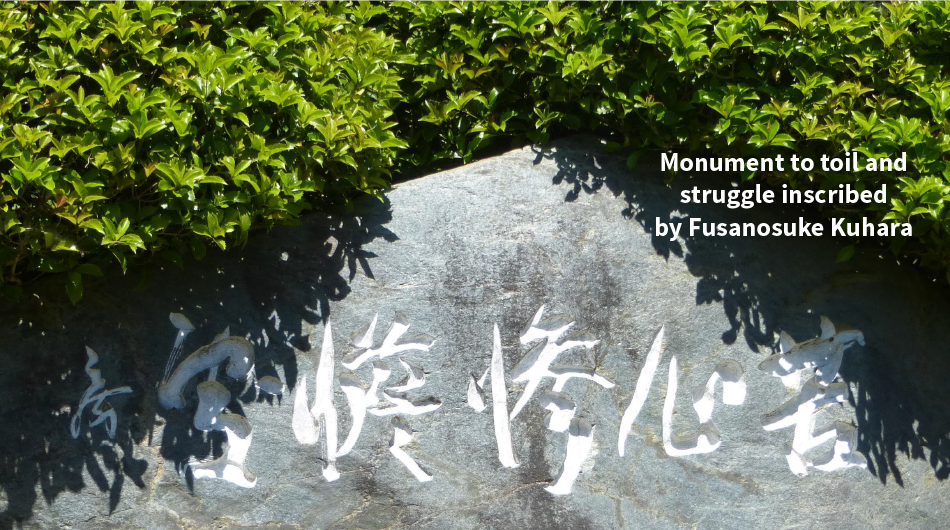 Amid rapidly rising demand for copper, Fusanosuke Kuhara went through real toil and struggle to achieve a favorable co-existence between the mine business and the local community on which its destiny depended. While many company founders leave noble words behind them, this inscription of “kushin santan” (toil and struggle) by Kuhara is a manifestation of his thinking and character.
Amid rapidly rising demand for copper, Fusanosuke Kuhara went through real toil and struggle to achieve a favorable co-existence between the mine business and the local community on which its destiny depended. While many company founders leave noble words behind them, this inscription of “kushin santan” (toil and struggle) by Kuhara is a manifestation of his thinking and character.
This accomplishment involved confronting the problem of pollution head-on to reduce the load on the environment, putting into practice “ethics and morals as they manifest in human societies as a whole” by seeking co-existence and co-prosperity with the local community without causing them harm. As such, it can be thought of as an extremely rare real-world example that led to the practical realization of “an ethics and morality founded in the entirety of nature,” encompassing more than just humanity.
Ethics and Early Days of Hitachi (Wellspring of Hitachi’s Ethics)
A study of the early days of the Hitachi Group gives one a sense that it was imbued with strong ideals regarding ethics from the very beginning. What prompted me to embark on such a study was advice from Professor Kenichi Miyamoto (Former President, Shiga University), who published “A Critical History of Environmental Pollution in Postwar Japan.” The early days of Hitachi Mine and Hitachi, Ltd. began in the period of industrial progress that came after the Russo-Japanese War (1904-1905). After graduating from the Electrical Engineering Department at the Imperial University College of Engineering, Namihei Odaira got a job at the Fujita-Gumi Kosaka Mine where he worked on the construction of an electrical generator (in 1900). Fusanosuke Kuhara, his supervisor at Kosaka Mine, purchased the Akazawa Copper Mine in Ibaraki Prefecture on December 12, 1905 and commenced operation under the name Hitachi Copper Mine from the 21st of that month. Kuhara started at the Kosaka Copper Mine of Fujita-Gumi in 1891 at the instruction of Denzaburo Fujita (Head of Fujita-Gumi, 1841-1912), his uncle from Hagi, and had success with the early adoption of the flash-smelting of black ore. However, internal disputes led to him leaving the Kosaka Copper Mine and relocating to the fresh ground of Hitachi. Meanwhile, Odaira likewise left the Kosaka Copper Mine for Hitachi. Here, we will skip over what he did in between as it is covered extensively elsewhere (it included his moving from the Hiroshima Electric Light Company to the Tokyo Electric Light Company, and also his talks with Motoji Shibusawa at the Daikokuya in Saruhashi). Suffice it to say, he left Tokyo Electric Light Company (what is now Tokyo Electric Power Co., Ltd.) and responded again to a call from Kuhara, from which we can imagine that Kuhara’s character held a strong fascination for him. When we look at Kuhara’s actions in the history of pollution, we get the impression of someone who acted as a corporate conscience and addressed environmental measures head-on, as noted in the commentary by Professor Miyamoto.
Figure 12—Hitachi Mine and Repair Shop in 1908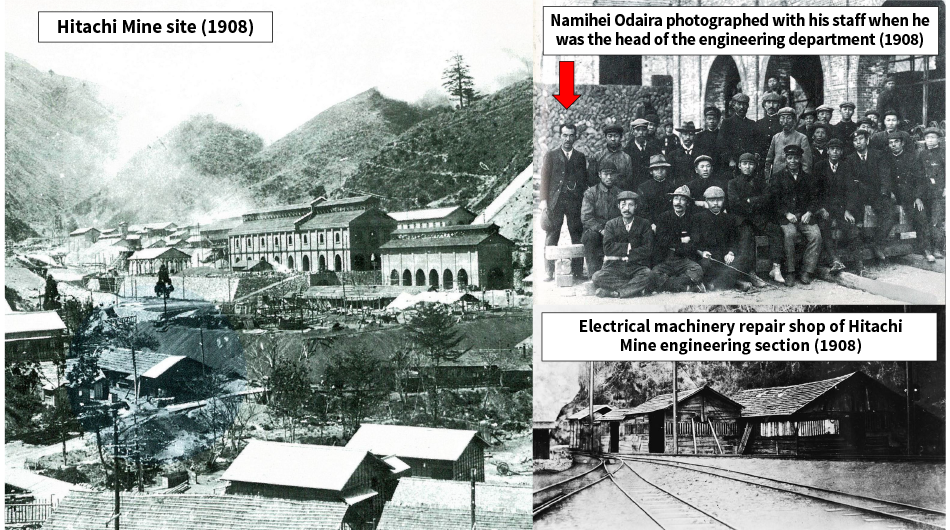 Hitachi’s founder, Namihei Odaira, joined the Kuhara Mining Company’s Hitachi Mine in 1906 to head the engineering department. These photographs show the mine two years later, in 1908. The photograph on the left shows Daioin, the hub of Hitachi Mine where the ore was dug up. On the top right is Namihei Odaira with his staff when he was the head of the engineering department. The bottom right shows the electrical machinery repair shop of Hitachi Mine’s engineering section, what would ultimately become the birthplace of Hitachi, Ltd.
Hitachi’s founder, Namihei Odaira, joined the Kuhara Mining Company’s Hitachi Mine in 1906 to head the engineering department. These photographs show the mine two years later, in 1908. The photograph on the left shows Daioin, the hub of Hitachi Mine where the ore was dug up. On the top right is Namihei Odaira with his staff when he was the head of the engineering department. The bottom right shows the electrical machinery repair shop of Hitachi Mine’s engineering section, what would ultimately become the birthplace of Hitachi, Ltd.
Environmental Contamination from Smelting and its Countermeasures
While Minamata Disease, in which the central nervous system is damaged by mercury, has been described as ground zero for global environmental problems, Japan had experienced problems with mining pollution at Ashio Copper Mine prior to this. History records the direct petition by the parliamentarian Shozo Tanaka to Emperor Meiji (in 1901). The sulfur dioxide gas that results from the smelting process is more than two times heavier than air, causing it to pool in the surrounding environment where it causes considerable harm. It has resulted in the death of woods as well as farmland, causing soil run-off from the denuded hillsides. Repeated flooding of the Watarase River, a river with a raised bed, led to the construction of flood-prevention ponds. Despite this, the large flood that occurred in the Fall of 2015 remains fresh in people’s memory. It was from the above Professor Miyamoto that I learned how the Hitachi Copper Mine represented an exception in the history of pollution. Some 40 or more years ago, I was engrossed in seeking a rapid and accurate way of measuring organic mercury, the cause of Minamata Disease, and subsequently I would often go walking in the environs of Hitachi’s Mount Kamine with my family. Although I found gemstone-like crystals in the tailings (discarded low-grade ore) of the Hitachi Copper Mine, the area was surprisingly free of anything distinctive of pollution. This was where my interest in the Hitachi Copper Mine first started.
Kuhara drew on the experience of the Kosaka Copper Mine, constructing a number of generators around the Hitachi region to enable extensive electrification. Large electric motors were also used to supply compressed air for powering equipment inside the mine. Indeed, it seems to me that the site became something of a miniature replica of the modern-day Hitachi Group, including generators, transformers, and power lines for electricity distribution; electric motors for use as a power source; a railway track with small electric locomotives for transportation; elevators in the form of a lift that ran deep into the mine works; electric lighting inside the mine; pneumatic rock drills; element analyzers; optical instruments for surveying; and weather observation devices with accompanying telemetry. This also extended to the lives of the people who worked at the mine. Extensive welfare facilities were developed, including staff housing, a cafeteria, shops, hospital, and school. Concern was also shown for those living nearby. Pollution compensation initially took the form of a reparation payment and gift paid annually. However, as production continued to climb, these compensation payments likewise ballooned to an extent that it became a problem for the business. As the aforementioned Professor Kenichi Miyamoto wrote, the Hitachi Great Chimney stands out as a landmark in the history of pollution mitigation in Japan, having been constructed with great toil and struggle during wartime when the need for copper production could have been used as an excuse.
Figure 13—Remnants that Recall Hitachi Mine’s Past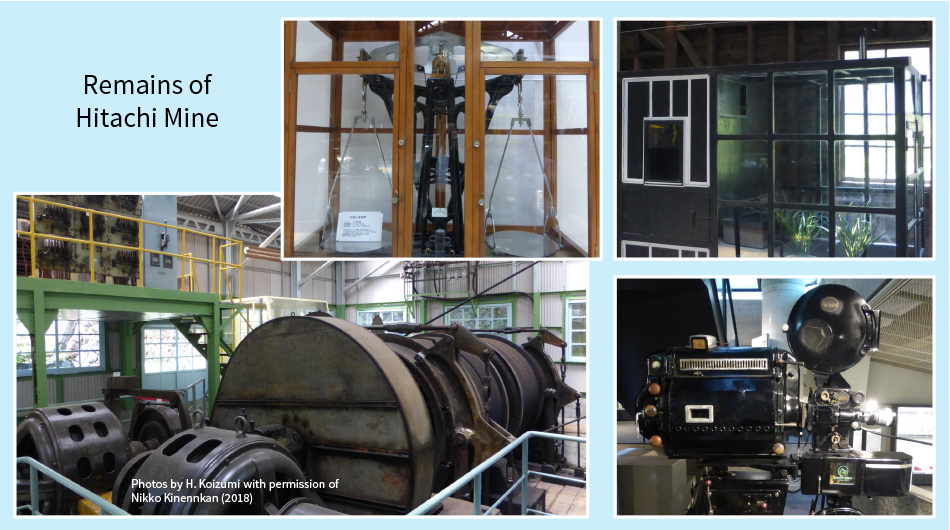 The large balance shown above on the top left was able to measure weights from 0.05 to 50,000 g with high accuracy. Accurate measurements, including ore analysis, underpin everything. Whether it was the measurement of weather conditions at high altitude to help prevent smoke damage or the use of optical instruments for surveying, this would in time evolve into a measuring instruments business. The photograph on the bottom left shows the hoist that raised and lowered the underground mine shaft lift. Being powered by an electric motor, it was a forerunner of the electric power business and production machinery as well as motors for electrical appliances. Steam engines were followed by the age of the electric motor. The top right shows an environmental test chamber for observing the effect of exhaust gases on plants, used to fulfill the mine’s destiny of taking early action on addressing pollution. The bottom right, meanwhile, shows the projector used in the Kyoraku-kan theatre. The theatre was designed as one of the welfare facilities provided for the mine’s many workers and their families. The design and construction of the Kyoraku-kan was undertaken by the mine’s engineers, with a design that referenced the Kabuki-za theatre in Tokyo and incorporated factory construction. In addition to providing a venue for famous singers, the facility also showed numerous movies at low prices.
The large balance shown above on the top left was able to measure weights from 0.05 to 50,000 g with high accuracy. Accurate measurements, including ore analysis, underpin everything. Whether it was the measurement of weather conditions at high altitude to help prevent smoke damage or the use of optical instruments for surveying, this would in time evolve into a measuring instruments business. The photograph on the bottom left shows the hoist that raised and lowered the underground mine shaft lift. Being powered by an electric motor, it was a forerunner of the electric power business and production machinery as well as motors for electrical appliances. Steam engines were followed by the age of the electric motor. The top right shows an environmental test chamber for observing the effect of exhaust gases on plants, used to fulfill the mine’s destiny of taking early action on addressing pollution. The bottom right, meanwhile, shows the projector used in the Kyoraku-kan theatre. The theatre was designed as one of the welfare facilities provided for the mine’s many workers and their families. The design and construction of the Kyoraku-kan was undertaken by the mine’s engineers, with a design that referenced the Kabuki-za theatre in Tokyo and incorporated factory construction. In addition to providing a venue for famous singers, the facility also showed numerous movies at low prices.
As it was clearly going to be some time before the technology for fully capturing sulfur dioxide gas was ready, there remained the problem of smoke carrying to distant locations where it left its mark on tobacco plant leaves and the like. What remains today are the “Centipede Chimney” that conveyed smoke emitted from the Daioin smelter along the ridge, “Chimney No. 3” for which the design by a government technical committee proved completely ineffectual, and the base (one-third height) of the “Hitachi Great Chimney” that once topped out at an altitude of 480.7 m above sea level and was only completed after great toil and struggle.
Zero pollution emissions were ultimately achieved in 1972 with the successful installation of equipment for capturing all of the sulfur dioxide gas and recovering it as sulfuric acid. It was shortly thereafter that I visited the Hitachi Great Chimney. With its work now accomplished, the Hitachi Great Chimney suddenly collapsed by natural causes in 1993, leaving only the lower one-third (57 m).
Companies that Fail to Uphold Ethics Fail to Survive
I touched upon the concept of “historicity” in the second article in Part 1 of this series, and in this sense it may be that much of what happened was due to the convictions of Fusanosuke Kuhara, someone who by historical coincidence just happened to be present. He appears to have shown little concern for self‐interest, believing that companies exist for the good of society. A person who held such convictions happened to appear in history at that time, purchasing the Akazawa Copper Mine and going on to accomplish this great feat.
That something like this was accomplished once in the past serves as a great encouragement for those of us living in the present. That present-day capitalism has its defects is widely accepted. Nevertheless, until some better alternative is found, we have no choice but to stick with it, making improvements as we go. One such improvement would be to follow a path back to the original capitalism that was founded in ethics. However, as Kuhara did, we need to face up to this honestly, putting the business’s very existence at stake. The sort of practices whereby businesses seek to be pardoned for the damage they do to the environment, even as they go on doing so, make no sense.
Column 7
Economic Inequality and the SDGs
Nature recently published an editorial on the SDGs entitled, “Reducing inequality benefits everyone - so why isn’t it happening?” [Nature 620, 468 (2023)].
The editorial was prompted by an open letter written in July 2023 by researchers from 67 nations to United Nations Secretary-general António Guterres and World Bank President Ajay Banga, urging them to “redouble efforts to address rising extreme inequality.”
A diagram showing the current state of global economic inequality appeared previously in this series about new ethics. The letter addressed the lack of progress on “Reduced Inequalities,” No. 10 of the United Nations’ 17 Sustainable Development Goals (SDGs), going so far as to say that it was being “largely ignored.”
I also see this problem as important in the context of what the SDGs are all about. While putting on an SDGs badge and puffing out our chests may be a first step toward showing the will to act, making explicit what each of us can do is, in my opinion, what the SDGs are for. It is a case of “Think globally, act locally.”
- Nature Portfolio: Discussion with Kiyohiro Houkin, Norihiro Suzuki, and Hideaki Koizumi;
- Nature, 559, No. 7868, July 22, 2021.
Listening to locals is key to building Society 5.0
Column 8
Reports on Inequality by Medical and Pharmacy Students
Masato Yasui is a Professor at the Keio University School of Medicine and the fourth director of the Keio University Global Research Institute (KGRI). He supervises an omnibus class entitled “Philosophy for Medical Students.” The course asks its fresh-faced new students, who have only recently passed their entrance exams, to think about what the true role of a doctor actually is. For some five years now, I have been helping out in this course during the first half of the first semester. In my most recent classes, I have raised the problem of inequality in its broad sense. A diagram compiled using Oxfam data (Figure 1 in the third article in Part 1 of this series) shows that, out of all of the new wealth being acquired across the entire global population, more than 80% of the total goes to the wealthiest 1%. Moreover, half of the people in the poor world have to get by on only 1% of the wealth. These disparities and inequities are already beyond what is ethical. Were this inequality such that all of the world’s people could still enjoy an income that is sufficient to live on, the situation might be forgivable. In actuality, however, when you consider how many of the children in the world’s poorest nations die through hunger or lack of access to healthcare, then surely it is beyond dispute that hoarding by the wealthy of more riches than they can ever use in their lifetimes represents an ethical failure. If the world’s wealthiest 1% were to donate 1% of what they acquire, it could double the poverty-level income received by half the world’s population. This reality struck at the hearts of these new medical school entrants who aspired to become doctors and pharmacists. I consulted with Professor Yasui, the course organizer, and set a report topic of “How can we persuade the wealthy to give away 1% of the wealth they acquire each year?” I was struck by the fresh thinking I found in these young peoples’ reports. I would very much like to collate them and present them in public some time.
Furthermore, there is a tendency for us to see the idea of corporates pursuing ethics or altruism as being idealistic. And yet, regardless of whether it is idealistic or not, it is something that has happened in the past. What is also highly persuasive is that the same Hitachi that accomplished this feat was also an advocate of ethics. One can also say that we have a duty to encourage more actions like this that are done for the benefit of society.
Markus Gabriel, whose name came up in the first article in Part 2 of this series, wrote that those companies that do not act ethically will not increase revenue and will be unlikely to survive. In saying this, he also asserted that, just like with the taxation and finance activities that are essential to sound business management, the companies of the future will also need to acquire expertise in the field of ethics. I feel the same way. It may be that at Hitachi, a company that has inherited a tradition of being an ethical company, part of my role over the past 20 or more years has been ethical expertise. In fact, in the case of work such as brain function measurements and the cohort studies undertaken as part of national projects that represent the ultimate in experimentation involving human beings, the first problem to arise has been that of the human rights of the subjects. As a result, I have had an application for approval of brain function measurements on infants in France accepted (in early 2000) by the bioethics committees for biomedical research in France, a group recognized as having taken such matters to greater extremes than anywhere else. I was also involved in setting up early ethics committees at Japanese government agencies for brain measurement experiments (1990s). I put a lot of work into establishing a new ethics committee dealing with considerations such as research coordination and domain oversight for national projects on brain research, including the Sukusuku Cohort [Japan Children’s Study (JCS)] in the 2000s. I also served as acting chair of the ethics committee at the Better Broadcasting for Children Project of the Broadcasting Culture Research Institute, part of Japan Broadcasting Corporation [Nippon Hoso Kyokai (NHK)].
Closing Words of Second Article in Part 2 of this Series: Mineral at Hitachi’s Origins Found to be Japan’s Oldest
While the corporate history of Hitachi, Ltd. often starts with an account of how the construction of the repair shop at Hitachi Mine was the event that set the company into being, establishing this account as an objectively scientific history requires that its origins be made clear, based on accurate records and primary sources.
The repair shop was situated in a corner of Kuhara Mining Company’s Hitachi Mine. This was the very heart of both Fusanosuke Kuhara, who took a holistic view of the real world, and Namihei Odaira, who was possessed of the same will and thought likewise. It is this that makes the repair shop the true origin of Hitachi, Ltd.
Fusanosuke Kuhara was forever observing the world and would on occasion venture resolutely beyond Japan. He thought on the same cosmic scale as Tesla. One can readily imagine how he came to be called “Wakusei” (planet) back them.
The Russian invasion of Ukraine that I addressed in the first article in Part 1 of this series is, I feel, not irrelevant to this discussion.
Meanwhile, there has been an unexpected new development regarding the Akazawa Mine site, the place that caught Fusanosuke Kuhara’s attention and became his first purchase. The results of recent isotope analyses have shown that it was formed during the Cambrian period of the Paleozoic era (from roughly 540 to 490 million years ago). Given that such ancient geological structures were not believed to exist in Japan until not so long ago, it made dating of the minerals and rocks at Hitachi Mine a subject of deep interest. With the “Anthropocene” having been proclaimed as a new epoch in geologic time, I find it fascinating that this discussion brings us to the Cambrian period, which featured the sudden emergence of most phyla (major taxonomic classification in biology) when many organisms first appeared.
In particular, the site that has been found to be the oldest in Japan is the Hitachi Mine Fudo Waterfall ore deposit. According to rhenium-osmium (Re-Os) radiometric dating, it formed about 530 million years ago during the early Cambrian period*.
- *
- T. Nozaki et.al, “Re-Os Geochronology of the Hitachi Volcanogenic Massive Sulfide Deposit: The Oldest Ore Deposit in Japan,” Economic Geology (2014).
Subsequently, in 2019, a new mineral was discovered in samples of ore taken from the Fudo Waterfall deposit inside Hitachi Mine. It was given the name, Hitachiite. It is thought that this material may also have some bearing on high-temperature superconductivity.* - *
- T. Kuribayashi et.al., “Hitachiite, Pb5Bi2Te2S6, a new mineral from the Hitachi mine, Ibaraki Prefecture, Japan,” Mineralogical Magazine (2019).

